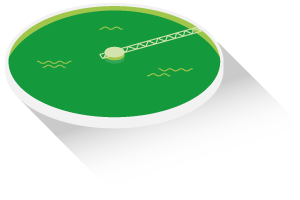Three processes for the production of microalgae are currently used
– In heterotrophic reactors or fermenters (fully enclosed)
– In open ponds
– Under glass tubes (photobioreactor)
Chlorella with variable properties and compositions are produced from these culture methods. Depending on whether they are produced in the light or not, in the open air or not, their composition will be different, especially in their vitamin B12 content, with or without associated bacteria ….
The processes in heterotrophic medium do not use the photosynthesis reaction of the alga. This one develops then by consuming the sugars which it finds in its medium of culture. This Chlorella does not contain vitamin B12.
More than the majority of Chlorella cultivated and consumed in the world is produced in heterotrophic reactors of fermenters type. It is therefore possible to find very cheap Chlorella on the market.
The production of Chlorella in photo bio reactors or in glass tubes is more than 10 times more expensive than in heterotrophic reactors. As for the production in open ponds, it is only 5 times higher than the cheapest production.
These industrial costs explain why very often producers in open ponds start the production in heterotrophic reactors and then continue in open ponds for the final phase.
These industrial costs also explain why we find in the trade more and more Chlorella said to be cultivated in a completely closed environment (in fermenter). They are therefore guaranteed pure but as they do not contain vitamin B12, this is added to them. These chlorella are therefore “rich in vitamin B12” but they are not “naturally rich in vitamin B12″. Depending on the type of vitamin B12 added, it is not certain that it is properly bio-absorbed by the body.
Production in open ponds cannot avoid contact with the environment and its contaminants, whether they come from the air (wind, insects, birds), water (rain) or soil (dust). It is necessary to sterilize the productions thus obtained.
The physical sterilization method used, on chlorella cultivated in open basins, cannot avoid breaking the cells of Chlorella. The promoters of this Chlorella have turned a technical disadvantage into a sales argument by explaining that the cells of the Chlorella must be open to be digestible. This is obviously false since the membrane of Chlorella opens naturally under the effect of the acidity of our stomach and it remains non assimilable by our body.
On the other hand, we can consider that the physical sterilization method used, which causes the cells of Chlorella to burst, degrades the product in the long term, whose cells, now open, no longer protect their precious contents.

The production in photo-bio-reactors or in glass tubes is done in a fully controlled and secured environment. All “inputs” are under control. Photosynthesis, favored by natural light, allows the plant to develop.
Less than 1% of the world’s production is grown under these conditions. But only this type of production, under glass tubes, can guarantee the best quality level of Organic Chlorella. The production costs of this Chlorella impose higher sales prices compared to other Chlorella, it is the price of quality.
There is only one industrial production of Chlorella in France. It is a Chlorella cultivated in fermenter. It is located in Lestrem. It entered production in 2014.

